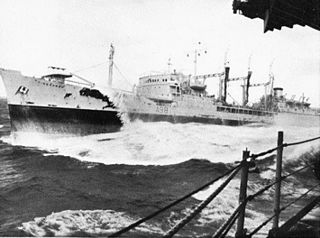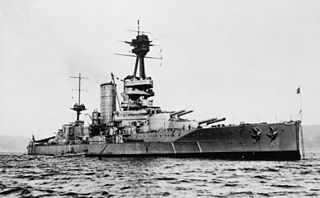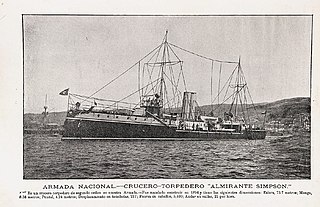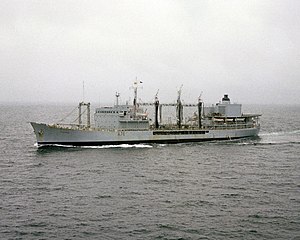
HMS Antrim was a County-class destroyer of the British Royal Navy launched on 19 October 1967. In the Falklands War, she was the flagship for the recovery of South Georgia, participating in the first ever anti-submarine operation successfully conducted exclusively by helicopters. In 1984, she was commissioned into the Chilean Navy, and renamed Almirante Cochrane.

Jorge Montt Álvarez was a vice admiral in the Chilean Navy and president of Chile from 1891 to 1896.

The Chilean Civil War of 1891 was a civil war in Chile fought between forces supporting Congress and forces supporting the President, José Manuel Balmaceda from 16 January 1891 to 18 September 1891. The war saw a confrontation between the Chilean Army and the Chilean Navy, siding with the president and the congress, respectively. This conflict ended with the defeat of the Chilean Army and the presidential forces, and with President Balmaceda committing suicide as a consequence of the defeat. In Chilean historiography the war marks the end of the Liberal Republic and the beginning of the Parliamentary Era.

The Battle of Angamos was a naval encounter of the War of the Pacific fought between the navies of Chile and Perú at Punta Angamos, on 8 October 1879. The battle was the culminating point of a naval campaign that lasted about five months in which the Chilean Navy had the sole mission of eliminating its Peruvian counterpart. In the struggle, two armored frigates, led by Commodore Galvarino Riveros Cárdenas and Navy Captain Juan José Latorre battered and later captured the Peruvian monitor Huáscar, under Rear Admiral Miguel Grau Seminario.

The Chilean Navy is the naval warfare service branch of the Chilean Armed Forces. It is under the Ministry of National Defense. Its headquarters are at Edificio Armada de Chile, Valparaiso.

Miguel María Grau Seminario was the most renowned Peruvian naval officer and hero of the naval battle of Angamos during the War of the Pacific (1879–1884). He was known as el Caballero de los Mares for his kind and chivalrous treatment of defeated enemies and is esteemed by both Peruvians and Chileans. He is an iconic figure for the Peruvian Navy, and one of the most famous merchant marine and naval military leaders of the Americas.

The Henry J. Kaiser class is an American class of eighteen fleet replenishment oilers which began construction in August 1984. The class comprises fifteen oilers which are operated by Military Sealift Command to provide underway replenishment of fuel to United States Navy combat ships and jet fuel for aircraft aboard aircraft carriers at sea.

Martin George Guisse, born Martin George Guise, and later known as Jorge Martín Guisse in Spanish, was a British naval officer who served in Royal Navy in the French Revolutionary and Napoleonic Wars. He later served in the Chilean Navy during the Peruvian War of Independence and, as Vice-Admiral, in the Peruvian Navy in the Gran Colombia–Peru War, during which he was killed.

The Tide class was a series of six replenishment oilers used by the British Royal Fleet Auxiliary (RFA), the Royal Australian Navy (RAN), and the Chilean Navy.

Almirante Óscar Viel was an icebreaker in service with the Chilean Navy in 1995–2019. Originally built for the Canadian Coast Guard as CCGS Norman McLeod Rogers, named for former Canadian Member of Parliament and cabinet minister Norman McLeod Rogers (1894–1940), the vessel was acquired by Chile in 1994 and renamed after Counter Admiral Óscar Viel y Toro (1837–1892), the commander of the Chilean naval forces from 1881 to 1883 and 1891.

The Revolutionary Junta of Iquique, was the political structure that was established to challenge the power of Chilean President José Manuel Balmaceda after the navy insurrection that started the 1891 Chilean Civil War. The junta ruled the country until Admiral Jorge Montt assumed power as the new president after Balmaceda's defeat.

Chilean frigate Almirante Condell (PFG-06) was a Condell-class frigate of the Chilean Navy, and was the third ship in the Chilean Navy to bear this name.

USNS Andrew J. Higgins (T-AO-190) was a Henry J. Kaiser-class oiler of the United States Navy which saw active service from 1987 to 1996. Sold to Chile in 2009, she was commissioned as Almirante Montt in the Chilean Navy in 2010.

Almirante Cochrane was a central battery ship of the Chilean Navy in the late nineteenth century. She was built, like her twin, Blanco Encalada, in the UK in 1875. She participated in the War of the Pacific, with her most prominent action being her victory over the Peruvian turret ram Huáscar in the Angamos naval battle. Almirante Cochrane was part of the forces that defeated President José Manuel Balmaceda in the Chilean Civil War of 1891.

Almirante Latorre, named after Juan José Latorre, was a super-dreadnought battleship built for the Chilean Navy. It was the first of a planned two-ship class that would respond to earlier warship purchases by other South American countries. Construction began at Elswick, Newcastle upon Tyne soon after the ship was ordered in November 1911, and was approaching completion when it was bought by the United Kingdom's Royal Navy for use in the First World War. Commissioned in September 1915, it served in the Grand Fleet as HMS Canada for the duration of the war and saw action during the Battle of Jutland.

The Almirante Latorre class consisted of two super-dreadnought battleships designed by the British company Armstrong Whitworth for the Chilean Navy. They were intended to be Chile's entries to the South American dreadnought race, but both were purchased by the Royal Navy prior to completion for use in the First World War. Only one, Almirante Latorre (HMS Canada), was finished as a battleship; Almirante Cochrane (HMS Eagle), was converted to an aircraft carrier. Under their Chilean names, they honored Admirals (Almirantes) Juan José Latorre and Thomas Cochrane; they took their British names from what was then a dominion of Canada and a traditional ship name in the Royal Navy.

The corvette Abtao was a wooden ship built in Scotland during 1864 of 1.600 tons and 800 IHP. She fought in the War of the Pacific and was in service for the Chilean Navy until 1922.

In the late nineteenth and early twentieth centuries, the South American nations of Argentina and Chile engaged in an expensive naval arms race to ensure the other would not gain supremacy in the Southern Cone.

Almirante Simpson was a unique design of torpedo gunboat, built by the British shipyard Laird Brothers. Acquired by the Chilean Navy in 1895, during construction. The ship had a brief service in Chile, being transferred to the Ecuadorian Navy in 1907 and renamed Libertador Bolívar. She was the first Ecuadorian warship of the 20th century and had an important participation in the Ecuadorian Civil War of 1913–1916. After the war, the ship was retired and then sank in 1928.



















